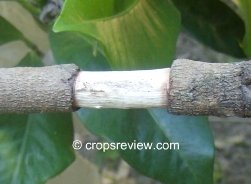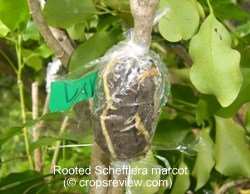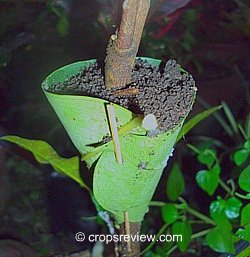Marcotting or air layering, an asexual or vegetative method of plant propagation, can be easily performed with less skill.
Air layering is just slightly different from other methods of layering such as tip layering, simple layering, compound or serpentine layering, etc.
In all these methods, the induction of root development is usually done by wounding the part of the plant to be rooted.
In this layering method, roots are induced to form on the part of the plant while it remains aerial (aboveground), hence the term air layering.
But in other layering methods, the same plant part is rooted on the ground usually by bending it downward.
Common Procedures in Marcotting
Plant and Shoot Selection

A shoot with plenty of leaves is chosen from a healthy plant.
The size of the stem at the part to be rooted is generally about that of an ordinary pencil, but this is not essential.
Both the thickness and length of the stem vary depending on the plant part to be layered (trunk, branch, or twig), the intended size of the marcotted plant to be produced, and the plant species.
In roses, the stems used in marcotting are normally thinner. In comparison, in herbaceous plants like aglaonema and dieffenbachia, the stems are thick.
Girdling and Scraping
This is unique in marcotting.
However, this procedure is skipped in bamboo and herbaceous plants.
For trees, shrubs, and semi-woody plants, a strip of bark is first removed from around the portion of the stem to be rooted.
This involves pressing a sharp knife against the bark preferably as close as possible below a node, moving the knife in a circular motion around the stem.
A similar cut is made generally about 2 cm to 5 cm below the first cut, but it can be wider with larger stems.
The two cuts are then connected by a straight cut and the bark is pried loose and removed.
The debarked portion of the stem is then scraped to remove the phloem and cambium, that slippery coating on the wood, to prevent the wound from healing and the upper and lower barks from reconnecting.
Slitting and Wedging
In herbaceous plants, an inward cut is made starting from below a node and slightly upward.
The cut has to traverse the horizontal line that marks the node at the point about half of the thickness of the stem and terminate above the same node.
In other words, this slanting cut must be able to severe the horizontal connection of the node.

Coir dust, sphagnum moss, a piece of wood, or any other suitable material is then inserted into the wound to serve as a wedge.
The purpose of this wedge is to keep the upper and lower cut surfaces apart and prevent healing just like in girdling and scraping.
Placing and Securing the Rooting Medium
A slightly moistened sphagnum moss or coconut coir dust is placed around the debarked stem and wrapped with a piece of plastic sheet.
A transparent plastic sheet is preferred to be able to see later if roots have developed.
In many plant species, however, the stems can be marcotted even with pure soil.
The rooting medium may be as thick as 1 inch (2.5 cm) from side to side or bigger depending on the earliness to develop roots and the size of the stem.
The longer is the time required to induce rooting and the bigger is the stem, the thicker should be the rooting medium.

Both ends of the plastic sheet are gathered and tied securely against the stem, with one end just under the bottom part of the debarked stem (lower cut) and the other a short distance above the upper part (uppercut).
It is important that the uppercut should be covered with the rooting medium because it is from this cut that roots form.
As an alternative, the plastic sheet may be placed first on the stem with one end tied just below the lower cut.
The rooting medium is then inserted gradually and the upper end of the plastic wrapping is tied securely to the stem.
This marcotting technique is more convenient and applies with any rooting medium which crumbles if not held by the hand.
To prevent breaking of the stem with a big and heavy rooting medium, it is tied to another branch or to a stick attached to the parent plant.
In stems that are more or less erect, the rooting medium can be held by any container such as broken or halved pots, cans, or plastic cups with an open top.
For big containers, support is needed to prevent them from dropping.
A container can be made also with a relatively thick plastic sheet with the bottom gathered and tied just below the lower cut and the top is expanded to form a shape like that of a funnel.
The sides are overlapped and stapled or fastened by piercing with a piece of thin stick.
In plants that easily form roots like Ficus and croton or san francisco (Codiaeum variegatum), this funnel-shaped container can be made out of some thick leaves.
The sides are secured in place by piercing with a stick.
The container is then filled with a rooting medium which is kept moist by regular watering.
Separation of the Marcot from the Parent Plant
The rooted shoots are severed from the parent plant when plenty of roots have developed. At this time the rooting medium becomes hard and rough when touched.
New shoots will also have sprouted from the portion of the stem immediately below the rooting medium.
In many plant species, this occurs at least 15 days from marcotting.
Potting
The marcotted shoot is immediately potted into a suitable container.
The intensity of care that will ensure the successful establishment of the layers will depend on various factors such as the size of the shoot, the size of the rooting medium, and the profuseness of the roots.
For maximum survival, the newly potted marcots are kept under partial shade and high humidity.
Suggestion: try it on croton (san francisco; Codiaeum variegatum) or balete (Ficus spp.). By actually doing it, you will realize very shortly how easy it is to propagate plants by marcotting.

What is the best soil for doing the Marcos?
propagation, hope this helps 🙂
marcotting is good 🙂